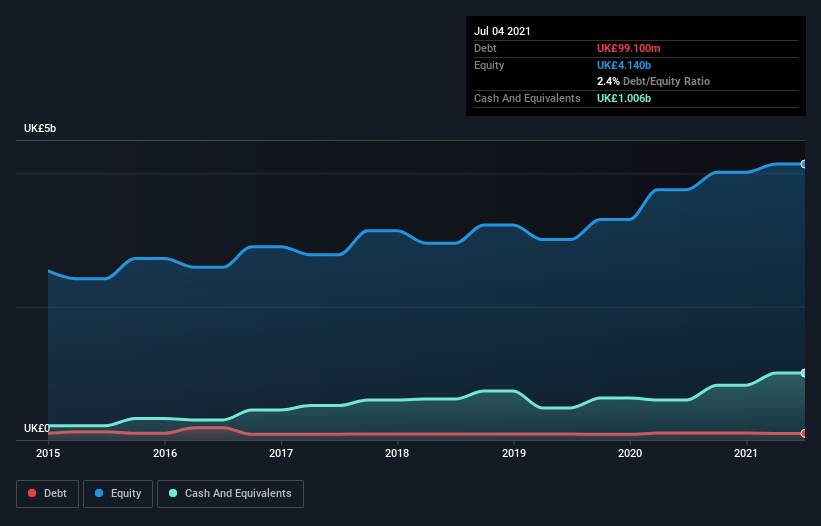Does Taylor Wimpey (LON:TW.) Have A Healthy Balance Sheet?
The external fund manager backed by Berkshire Hathaway's Charlie Munger, Li Lu, makes no bones about it when he says 'The biggest investment risk is not the volatility of prices, but whether you will suffer a permanent loss of capital.' It's only natural to consider a company's balance sheet when you examine how risky it is, since debt is often involved when a business collapses. Importantly, Taylor Wimpey plc (LON:TW.) does carry debt. But the more important question is: how much risk is that debt creating?
When Is Debt Dangerous?
Debt is a tool to help businesses grow, but if a business is incapable of paying off its lenders, then it exists at their mercy. In the worst case scenario, a company can go bankrupt if it cannot pay its creditors. However, a more common (but still painful) scenario is that it has to raise new equity capital at a low price, thus permanently diluting shareholders. Of course, debt can be an important tool in businesses, particularly capital heavy businesses. The first thing to do when considering how much debt a business uses is to look at its cash and debt together.
See our latest analysis for Taylor Wimpey
How Much Debt Does Taylor Wimpey Carry?
The image below, which you can click on for greater detail, shows that Taylor Wimpey had debt of UK£99.1m at the end of July 2021, a reduction from UK£104.5m over a year. However, its balance sheet shows it holds UK£1.01b in cash, so it actually has UK£906.5m net cash.
How Healthy Is Taylor Wimpey's Balance Sheet?
Zooming in on the latest balance sheet data, we can see that Taylor Wimpey had liabilities of UK£1.12b due within 12 months and liabilities of UK£895.5m due beyond that. Offsetting these obligations, it had cash of UK£1.01b as well as receivables valued at UK£154.8m due within 12 months. So it has liabilities totalling UK£857.0m more than its cash and near-term receivables, combined.
Of course, Taylor Wimpey has a market capitalization of UK£5.74b, so these liabilities are probably manageable. But there are sufficient liabilities that we would certainly recommend shareholders continue to monitor the balance sheet, going forward. Despite its noteworthy liabilities, Taylor Wimpey boasts net cash, so it's fair to say it does not have a heavy debt load!
In addition to that, we're happy to report that Taylor Wimpey has boosted its EBIT by 40%, thus reducing the spectre of future debt repayments. When analysing debt levels, the balance sheet is the obvious place to start. But ultimately the future profitability of the business will decide if Taylor Wimpey can strengthen its balance sheet over time. So if you're focused on the future you can check out this free report showing analyst profit forecasts.
Finally, while the tax-man may adore accounting profits, lenders only accept cold hard cash. Taylor Wimpey may have net cash on the balance sheet, but it is still interesting to look at how well the business converts its earnings before interest and tax (EBIT) to free cash flow, because that will influence both its need for, and its capacity to manage debt. In the last three years, Taylor Wimpey's free cash flow amounted to 48% of its EBIT, less than we'd expect. That weak cash conversion makes it more difficult to handle indebtedness.
Summing up
Although Taylor Wimpey's balance sheet isn't particularly strong, due to the total liabilities, it is clearly positive to see that it has net cash of UK£906.5m. And we liked the look of last year's 40% year-on-year EBIT growth. So we don't think Taylor Wimpey's use of debt is risky. The balance sheet is clearly the area to focus on when you are analysing debt. But ultimately, every company can contain risks that exist outside of the balance sheet. These risks can be hard to spot. Every company has them, and we've spotted 2 warning signs for Taylor Wimpey you should know about.
If, after all that, you're more interested in a fast growing company with a rock-solid balance sheet, then check out our list of net cash growth stocks without delay.
This article by Simply Wall St is general in nature. We provide commentary based on historical data and analyst forecasts only using an unbiased methodology and our articles are not intended to be financial advice. It does not constitute a recommendation to buy or sell any stock, and does not take account of your objectives, or your financial situation. We aim to bring you long-term focused analysis driven by fundamental data. Note that our analysis may not factor in the latest price-sensitive company announcements or qualitative material. Simply Wall St has no position in any stocks mentioned.
Have feedback on this article? Concerned about the content? Get in touch with us directly. Alternatively, email editorial-team (at) simplywallst.com.

 Yahoo Finance
Yahoo Finance 
